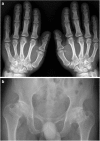Pathogenic gene screening in 91 Chinese patients with short stature of unknown etiology with a targeted next-generation sequencing panel
- PMID: 30541462
- PMCID: PMC6292044
- DOI: 10.1186/s12881-018-0730-6
Pathogenic gene screening in 91 Chinese patients with short stature of unknown etiology with a targeted next-generation sequencing panel
Abstract
Background: Dwarfism is a common severe growth disorder, but the etiology is unclear in the majority of cases. Recombinant human growth hormone may be a treatment option, but it has limited efficacy. The currently known laboratory assays do not meet the precision requirements for clinical diagnosis. Here, we have constructed a targeted next-generation sequencing (NGS) panel of selected genes that are suspected to be associated with dwarfism for genetic screening.
Methods: Genetic screening of 91 children with short stature of unknown etiology was performed with the help of the NGS panel. All the coding regions and exon-intron boundaries of 166 genes were included in the panel. To clarify the pathogenicity of these mutations, their clinical data were reviewed and analyzed.
Results: The assay identified p.A72G, p.I282V, and p.P491S variants of the PTPN11 gene and a p.I437T variant of the SOS1 gene in 4 cases with Noonan syndrome. A frameshift mutation (p.D2407fs) of the ACAN gene was identified in a case of idiopathic short stature with moderately advanced bone age. A p.R904C variant of the COL2A1 gene was found in a patient, who was accordingly diagnosed with Stickler syndrome. Severe short stature without limb deformity was associated with a p.G11A variant of HOXD13. In addition, we evaluated evidence that a p.D401N variant of the COMP gene may cause multiple epiphyseal dysplasia.
Conclusions: Our findings suggest that syndromes, particularly Noonan syndrome, may be overlooked due to atypical clinical features. This gene panel has been verified to be effective for the rapid screening of genetic etiologies associated with short stature and for guiding precision medicine-based clinical management.
Keywords: Next generation sequencing (NGS); Pathogenic genes; Short stature; Targeted panel; Unknown etiology.
Conflict of interest statement
Ethics approval and consent to participate
The study was approved by the Ruijin Hospital Ethics Committee Shanghai JiaoTong University School of Medicine. Informed written consent was obtained from participants or their guardians. In our study, 90 cases were under the age of 16; for these participants, their guardian provided written informed consent. In addition, one case of 16.7 years provided written informed consent.
Consent for publication
Not Applicable.
Competing interests
The authors declare that they have no competing interests.
Publisher’s Note
Springer Nature remains neutral with regard to jurisdictional claims in published maps and institutional affiliations.
Figures
Similar articles
-
A novel mutation in the COL2A1 gene in a patient with Stickler syndrome type 1: a case report and review of the literature.J Med Case Rep. 2017 Aug 26;11(1):237. doi: 10.1186/s13256-017-1396-y. J Med Case Rep. 2017. PMID: 28841907 Free PMC article. Review.
-
Mutation survey and genotype-phenotype analysis of COL2A1 and COL11A1 genes in 16 Chinese patients with Stickler syndrome.Mol Vis. 2016 Jun 23;22:697-704. eCollection 2016. Mol Vis. 2016. PMID: 27390512 Free PMC article.
-
Case report of the first molecular diagnosis of Stickler syndrome with a pathogenic COL2A1 variant in a Mongolia family.Mol Genet Genomic Med. 2021 Oct;9(10):e1781. doi: 10.1002/mgg3.1781. Epub 2021 Aug 18. Mol Genet Genomic Med. 2021. PMID: 34405586 Free PMC article.
-
Genetic testing results of children suspected to have Stickler syndrome type collagenopathy after ocular examination.Mol Genet Genomic Med. 2021 May;9(5):e1628. doi: 10.1002/mgg3.1628. Epub 2021 May 5. Mol Genet Genomic Med. 2021. PMID: 33951325 Free PMC article.
-
Stickler Syndrome.Adv Exp Med Biol. 2025;1467:215-218. doi: 10.1007/978-3-031-72230-1_42. Adv Exp Med Biol. 2025. PMID: 40736844 Review.
Cited by
-
Hsa_circularRNA_0079201 suppresses chondrocyte proliferation and endochondral ossification by regulating the microRNA‑140‑3p/SMAD2 signaling pathway in idiopathic short stature.Int J Mol Med. 2020 Dec;46(6):1993-2006. doi: 10.3892/ijmm.2020.4737. Epub 2020 Sep 25. Int J Mol Med. 2020. PMID: 33125098 Free PMC article.
-
Growth Hormone Treatment for Non-GHD Disorders: Excitement Tempered by Biology.J Clin Endocrinol Metab. 2024 Jan 18;109(2):e442-e454. doi: 10.1210/clinem/dgad417. J Clin Endocrinol Metab. 2024. PMID: 37450564 Free PMC article. Review.
-
Genotype and phenotype in patients with ACAN gene variants: Three cases and literature review.Mol Genet Genomic Med. 2024 Apr;12(4):e2439. doi: 10.1002/mgg3.2439. Mol Genet Genomic Med. 2024. PMID: 38613222 Free PMC article. Review.
-
Focused Revision: ACMG practice resource: Genetic evaluation of short stature.Genet Med. 2021 May;23(5):813-815. doi: 10.1038/s41436-020-01046-0. Epub 2021 Jan 29. Genet Med. 2021. PMID: 33514815 No abstract available.
-
Identification of novel ACAN mutations in two Chinese families and genotype-phenotype correlation in patients with 74 pathogenic ACAN variations.Mol Genet Genomic Med. 2021 Nov;9(11):e1823. doi: 10.1002/mgg3.1823. Epub 2021 Oct 3. Mol Genet Genomic Med. 2021. PMID: 34605228 Free PMC article.
References
-
- Argente J. Challenges in the Management of Short Stature. Horm Res Paediatr. 2016;85(1):2–10. - PubMed
-
- Li H, Ji CY, Zong XN, Zhang YQ. Height and weight standardized growth charts for Chinese children and adolescents aged 0 to 18 years. Chin J Pediatrics. 2009;47(7):487–492. - PubMed
-
- Xu SS, Gu XF, Pan H, Zhu HJ, Gong FY, Li YF, Xing YM. Reference values for serum IGF-1 and IGFBP-3 in children and adolescents. J Clin Pediatrics. 2009;27(12):1105–1110.
Publication types
MeSH terms
Substances
Supplementary concepts
LinkOut - more resources
Full Text Sources
Medical
Miscellaneous



